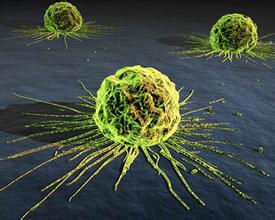
在许多癌症中,癌细胞的扩散才是最致命的威胁。人们往往可以通过手术、药物、化疗或者放疗成功治疗原发瘤,然而一旦癌症扩散到机体的其他器官就很难再进行遏制。科学家们一直在尝试阻断癌细胞的转移途径,但目前成效并不理想。
Georgetown Lombardi癌症中心的研究人员在Oncogene杂志上发表了惊人的发现,紧紧挤在一起的癌细胞突然改变心意放弃了扩散,而这一现象与控制器官大小的细胞通路有关。
“癌症治疗真正需要的是想办法阻止癌细胞在转移位点生长,而我们发现的机制似乎可以做到这一点,”文章的资深作者Anton Wellstein教授说。
Wellstein实验室的Ghada M. Sharif博士注意到,与在低密度环境中生长的癌细胞相比,高密度的癌细胞在侵袭组织的时候效率比较低。他和同事为此进行了深入的研究。
研究人员发现,高密度的癌细胞激活了Hippo分子通路,这是一个限制器官大小的古老生物学机制。低密度的癌细胞不能激活Hippo,因此可以在器官内不受控制的生长。进一步研究显示,在癌细胞中激活Hippo的是一个被称为YAP的分子。“Hippo通路是癌细胞中激活的,这令我们非常惊讶,”Wellstein说。
“根据Hippo通路是否激活,就能决定癌细胞是不是能够侵袭,这一点非常棒,”Wellstein说。“侵袭细胞和非侵袭细胞在遗传学上是完全一样的,唯一的区别是Hippo通路的活化情况。”
研究人员指出,这一机制是多种癌症所共有的,包括乳腺癌、前列腺癌、胰腺癌和肺癌。人们一直把癌细胞视为完全脱离控制的疯狂细胞,它们侵袭性很强而且根本停不下来。但这项研究表明,癌细胞在挤成一团的时候仍然受到古老规则的控制,这是一个意义重大的发现。
许多癌症在早期阶段就会发生转移,以Hippo通路为基础开发抗癌药物,可以在癌转移时限制癌细胞在器官中的传播。“这项研究揭示的机制对于癌细胞的侵袭和转移直至关重要,我们已经鉴定了这一机制的驱动者,不过还有许多工作等待我们去完成,”Wellstein说。
原文链接:Cell growth density modulates cancer cell vascular invasion via Hippo pathway activity and CXCR2 signaling
metastasis of cancer cells involves multiple steps, including their dissociation from the primary tumor and invasion through the endothelial cell barrier to enter the circulation and finding their way to distant organ sites wher they extravasate and establish metastatic lesions. Deficient contact inhibition is a hallmark of invasive cancer cells, yet surprisingly the vascular invasiveness of commonly studied cancer cell lines is regulated by the density at which cells are propagated in culture. Cells grown at high density were less effective at invading an endothelial monolayer than cells grown at low density. This phenotypic difference was also observed in a zebrafish model of vascular invasion of cancer cells after injection into the yolk sac and extravasation of cancer cells into tissues from the vasculature. The vascular invasive phenotypes were reversible. A kinome-wide RNA interference screen was used to identify drivers of vascular invasion by panning small hairpin RNA (shRNA) library-transduced noninvasive cancer cell populations on endothelial monolayers. The selecion of invasive subpopulations showed enrichment of shRNAs targeting the large tumor suppressor 1 (LATS1) kinase that inhibits the activity of the transcriptional coactivator yes-associated protein (YAP) in the Hippo pathway. Depletion of LATS1 from noninvasive cancer cells restored the invasive phenotype. Complementary to this, inhibition or depletion of YAP inhibited invasion in vitro and in vivo. The vascular invasive phenotype was associated with a YAP-dependent upregulation of the cytokines IL6, IL8 and C-X-C motif ligand 1, 2 and 3. Antibody blockade of cytokine receptors inhibited invasion and confirmed that they are rate-limiting drivers that promote cancer cell vascular invasiveness and could provide therapeutic targets.

